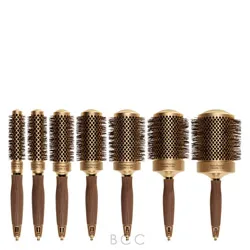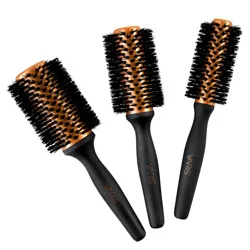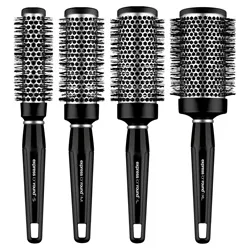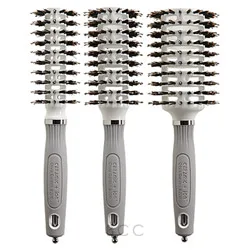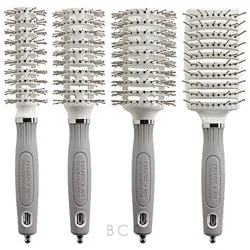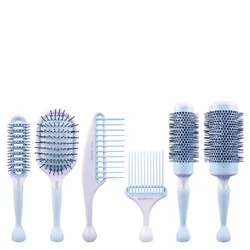Quick Guide: Hair Brush 101
The right combination of bristles, barrels, and brush shapes can unlock the best hair of your life. The right brush can be the tool you've been missing to achieve gorgeous hair that moves and grows with you. Here's how to choose the best for your hair, plus how to boost its styling and staying powers.
There are essentially three parts to each brush:
- Brush Shape
- Brush Barrel
- Brush Bristle
Selecting the right combination that works for your style generally isn't a "one size fits all" answer. That's why most women have at least three different brushes.
Brush Shapes
-
Paddle: Best for Creating Volume & Curl
Paddle brushes (sometimes called flat brushes) are meant to create a straight look that works on both long hair and straight-styled bobs. They're usually made of nylon bristles and are used to dry larger areas to a flat, smooth finish.
Achieve the smooth look: Hold in the more comfortable hand with the bristles up and direct the hair dryer pointing down the hair to smooth the cuticle and dry on a downward direction. It should be used only to dry from the nape to the crown, and then the sides to the top from roots to ends. Grab a round brush for the front of your hair to shape the pieces that frame your face.
-
Round: Best for Adding Serious Height & Supporting Updos
Round brushes are made to give you body and movement wherever you need it"”be it volume at the root, a bend in the middle of the hair, or a nice natural curl at the bottom. The size of the barrel will dictate how much curl or volume can be achieved.
If you have short hair or bangs, choose a smaller brush for those areas. The bigger the brush, the straighter the look you'll achieve. The high temp from your blow-dryer will heat up the barrel, effectively turning your brush into a curling iron.
Use a round brush to create volume: hook the brush under a 2-inch section of hair at the root, and lift as you roll it through to the ends"”all the while following the brush with the dryer. Keep the nozzle above your brush and pointed down to increase shine.
For the perfect blowout curl, grip the brush and run through the hair from the middle to the end, turning the hair in the direction of your face and follow with the blow dryer. Then, take the blow-dryer away from the hair and let it "cool" on the brush to set the curl. Gently pull the brush out of the hair and resist pulling at it with your fingers. Spray and allow to set before finishing.
-
Teasing: Best for Daily Use
Teasing brushes are usually thin with rigid nylon or plastic bristles. Use one on the root area in a gentle back-brushing motion to add volume that'll last through the night. Smooth over the top layer for a sweeping updo or a professional half-up style. And the pointed end? Great for separating sections and creating exact parts. However, we don't recommend using this brush if you have fine or fragile hair.
Brush Barrels
The right type of barrel can give you a shiny, frizz-free finish when you blow-dry your hair, which is especially helpful if you have curly, dull or damaged hair, Plus, picking the best barrel for your buck can speed up the drying process. Each of these different materials has benefits for different hair types. Barrel sizes range from very small to extra large. Your hair style and the amount of curl you want will help you select the right size (or maybe even 2 different sizes.)
-
Ceramic: Best for Sore Hands, Damaged Strands, & Long Hair
Ceramic is the most popular barrel material. Much like ceramic cookware, ceramic barrels maintain a gentle, healthy level of heat to aid in the drying process. Most ceramic brushes have holes through the barrel to allow both sides of the hair to dry, so you get a speedy and consistent blowout every time.
-
Tourmaline: Best for Medium, Thick, & Coarse Hair
Sometimes called ion brushes, tourmaline barrel brushes are made from crushed gemstones that release negative ions. These ions help smooth hair and reduce static electricity"”great for winter months. For the best blowout, experts are in agreement: Use ceramic and tourmaline combo brushes.
-
Titanium, Thermal & Vented: Best for Fine to Medium Strands
There are a few variations on the ceramic and tourmaline brushes: Titanium brushes coated with ceramic provide similar benefits to a ceramic brushes, but are slightly more lightweight. A "thermal" brush means it aims to regulate the heat to protect hair, much like ceramic.
Vented flat brushes are good for smoothing while you detangle, and vented round brushes have holes to distribute the heat for consistency throughout your blowout.
Brush Bristles
Your choice of brush always depends on your hair type. Most hair types will benefit from a mixed bristle brush"”half nylon, half boar.
But here's the tricky part: The color and texture of your hair changes with age. If your hair has become thin or dry, we suggest a natural bristle brush. A natural bristle brush will help redistribute sebum from the scalp which, in turn, moisturizes the lengths of the hair. These bristles also work to stimulate the scalp, which promote healthy hair growth.
-
Boar
True boar bristle brushes are made from 100% natural (humanely cultivated) wild boar hair. They should be tightly packed together and feel stiff, but with some flexibility. These bristles distribute oils evenly throughout strands and are great for achieving a smooth, shiny blowout. The downside? They come at a bit of a price compared to synthetic bristles.
If you have thick, course hair that requires tug to achieve fullness, boar bristle brushes are worth the investment. They make styling easier and promote shine and smoothness"”benefits almost everyone wants. If you have fine hair and own one of these brushes, your investment isn't lost; boar bristles can add volume to fine and normal hair types"”as long as your brush has a nice natural give.
-
Nylon
Nylon bristles are less expensive than boar brushes, but still effective. The bristles are usually spaced farther apart than boar and achieve a medium to strong grip on all hair types, especially those with medium density or finer strands, says Arrojo. The better the grip, the smoother and straighter your style will be. If brushes tend to get stuck in your hair mid-twirl or you suffer from serious static issues, try a brush that combines nylon and boar bristles.
-
Plastic
Plastic and synthetic bristles are your general, all-purpose brushes. The bristles are incredibly strong, made for working through larger areas of medium to thick hair. These are a "first step" kind of brush; best for detangling and preliminary blow-drying. When you've removed most of the excess water, switch to a round boar or nylon brush for styling, smoothing, and adding shine.
Like your hair, the brush itself needs some TLC to stay in tip-top shape. Dust, oil, and product build up and can get trapped in your brush, making your hair look dull while not providing the bristles with enough grip to style your hair properly. Here's how to care for it:
- Remove hair from the bristles with your fingers, or use scissors to cut out larger clumps.
- Clean your brush about every two weeks: Fill a small bowl with warm water and shampoo, swish the brushes around, rinse thoroughly, and then lay flat, bristle side down, to dry or wipe with a paper towel.
- Replace your brush when the bristles are fraying.
- A good quality brush should last about three years, maybe longer, if it is well-maintained.

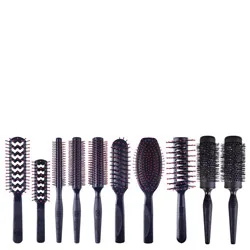
 write a review
write a review
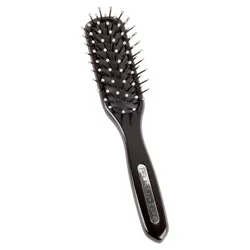
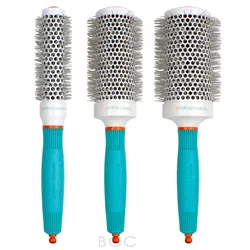
 write a review
write a review
